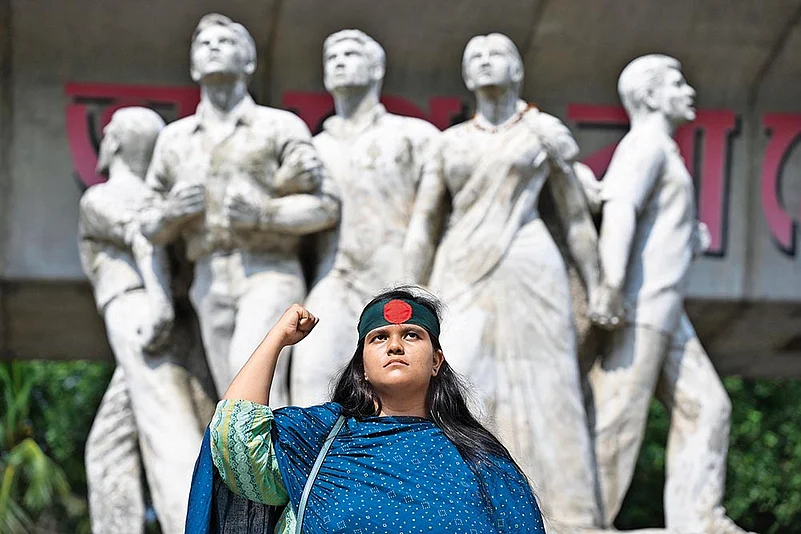Janus-Faced Countries
Bangladesh Diary: The Best Of Times And The Worst Of Times
Bangladesh as she is now, and the Bangladesh that its students and citizens hope to build for a shared and brighter future

Recent weeks in Bangladesh have been reminiscent of the opening line from Dickens’ A Tale of Two Cities, “It was the best of times, it was the worst of times.” What began as a peaceful student protest against government job quotas was met with unconscionable violence, resulting in the deaths of many students and ultimately leading to countrywide demands for the government to step down.
The uncertainty and the terrible human toll have left no-one here unaffected. From my home, I heard gunfire and the roar of conflict several days running, and friends in other parts of the city described even worse violence. But these events have also been an education in how hope can persist in situations that seem devoid of any rationale for such hope.
Outside Bangladesh, some may consider these events unexpected, but the underlying reasons have deep roots in the dissatisfaction about the promise of an independent Bangladesh in 1971, and the reality of what was delivered by successive regimes. Despite improved human development indicators and economic growth (women’s labour force participation in Bangladesh is higher than in India and until recently Bangladesh’s per capita income was higher than India’s), anger over pervasive corruption and political repression has overshadowed the country’s achievements.
Concessions granted to India during Indo-Bangla negotiations have also fostered resentment, worsened by initial media coverage in India suggesting the protesters were influenced by external players. On the ground, no-one doubts that this has been an entirely homegrown movement. Suggesting otherwise demonstrates profound disrespect for the role of the students and dismisses the agency of Bangladesh to make its own decisions as an independent nation. If the government could indeed be overthrown by the machinations of “foreign actors”, it would surely have happened already! Attributing the unrest to such influences, including Pakistan’s Inter-Services Intelligence (ISI) and its local allies, has not contributed to neighbourhood bridge-building.
Similarly, the attempt to portray the incidents of violence against minority communities ignored the relatively limited nature of these utterly shameful and heinous attacks in favour of active or passive misinformation, and an attempt to frame everything in simplistic communal terms. By contrast, there was very little coverage of student and community efforts to safeguard minorities and their places of worship by organising patrols and night-time vigils. The diversity within the youthful alliance was clearly visible, with both males and females sporting T-shirts and jeans working alongside madrassa students and girls in hijab. Even costumed characters joined in!
As someone with many Indian friends and a keen awareness of our shared history and contemporary national interests, the biases in Indian reporting in the early days were infuriating. Thankfully, some media outlets are providing more nuanced and fact-based reportage now. Hopefully mainstream Indian media will continue that trend.
History has demonstrated, whether in Vietnam-era America or the 1952 Language Movement in East Pakistan, that youth uprisings are almost impossible to quell without unimaginable bloodshed. And that is because, unlike most people over thirty-five—despite having their whole life ahead of them—young people are often courageous enough to act as though they have nothing to lose. Members of Generation Z, too often dismissed as phone-toting zombies, have proved their mettle in the face of attempts to silence them.
This movement saw large-scale participation by women—not least the female students of Rokeya Hall who were the first to take to the streets in the most recent protests. When student leaders Nusrat, Rafiat and Umama spoke with The Daily Star of their hopes for a new Bangladesh, it was moving to hear their dreams of a country where all cases of gender-based violence are investigated properly; where the concerns of ordinary people are shared by students; and where future generations will not feel they face a choice between sacrificing their freedoms or leaving the country for a better life abroad.
Like many of my fellow citizens, I am hopeful but lack any certainty of what lies ahead for Bangladesh. We face daunting challenges, but we have seen what this new generation is capable of. Now, we need to be patient and let the interim government do its job. Because in the end, it comes down not to a tale of two cities, but a question of two countries: Bangladesh as she is now, and the Bangladesh that its students and citizens hope to build for a shared and brighter future.
Farah Ghuznavi is a writer, translator and development professional
(This appeared in the print as 'Bangladesh Diary')
-
Previous Story
 2024 Nobel Prize In Chemistry Goes To David Baker, Demis Hassabis, John M Jumper: 'It's About Proteins'
2024 Nobel Prize In Chemistry Goes To David Baker, Demis Hassabis, John M Jumper: 'It's About Proteins' - Next Story



















